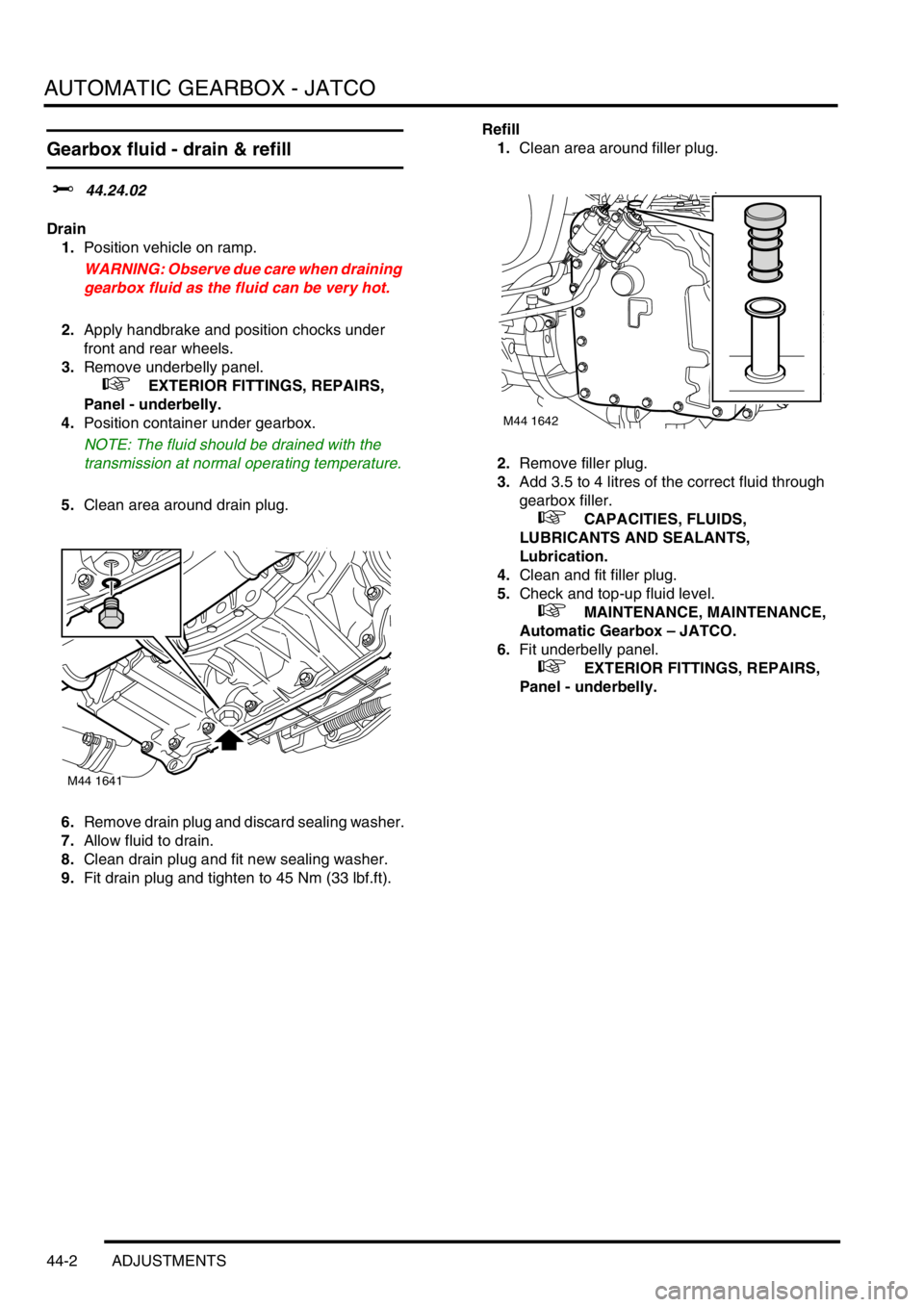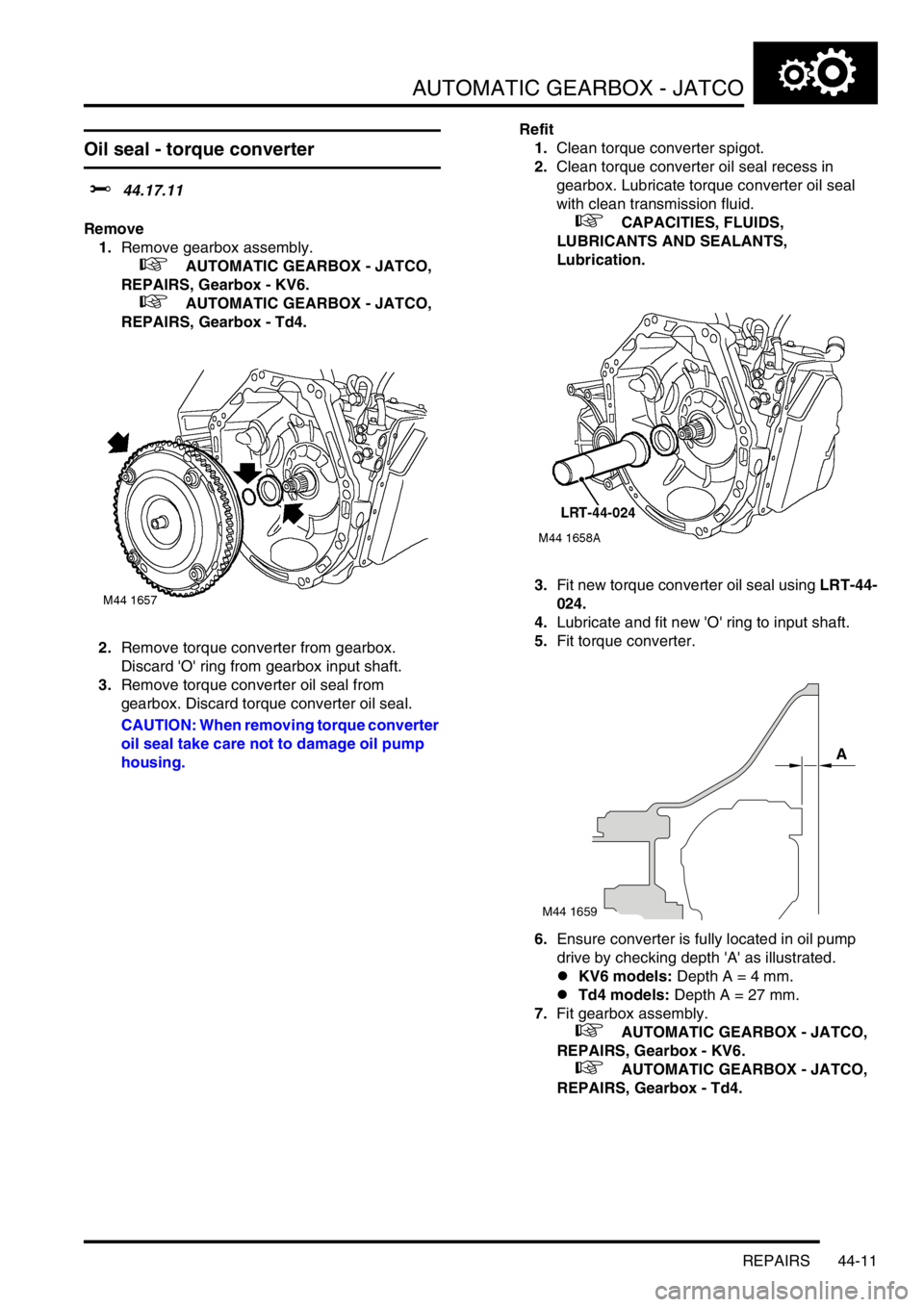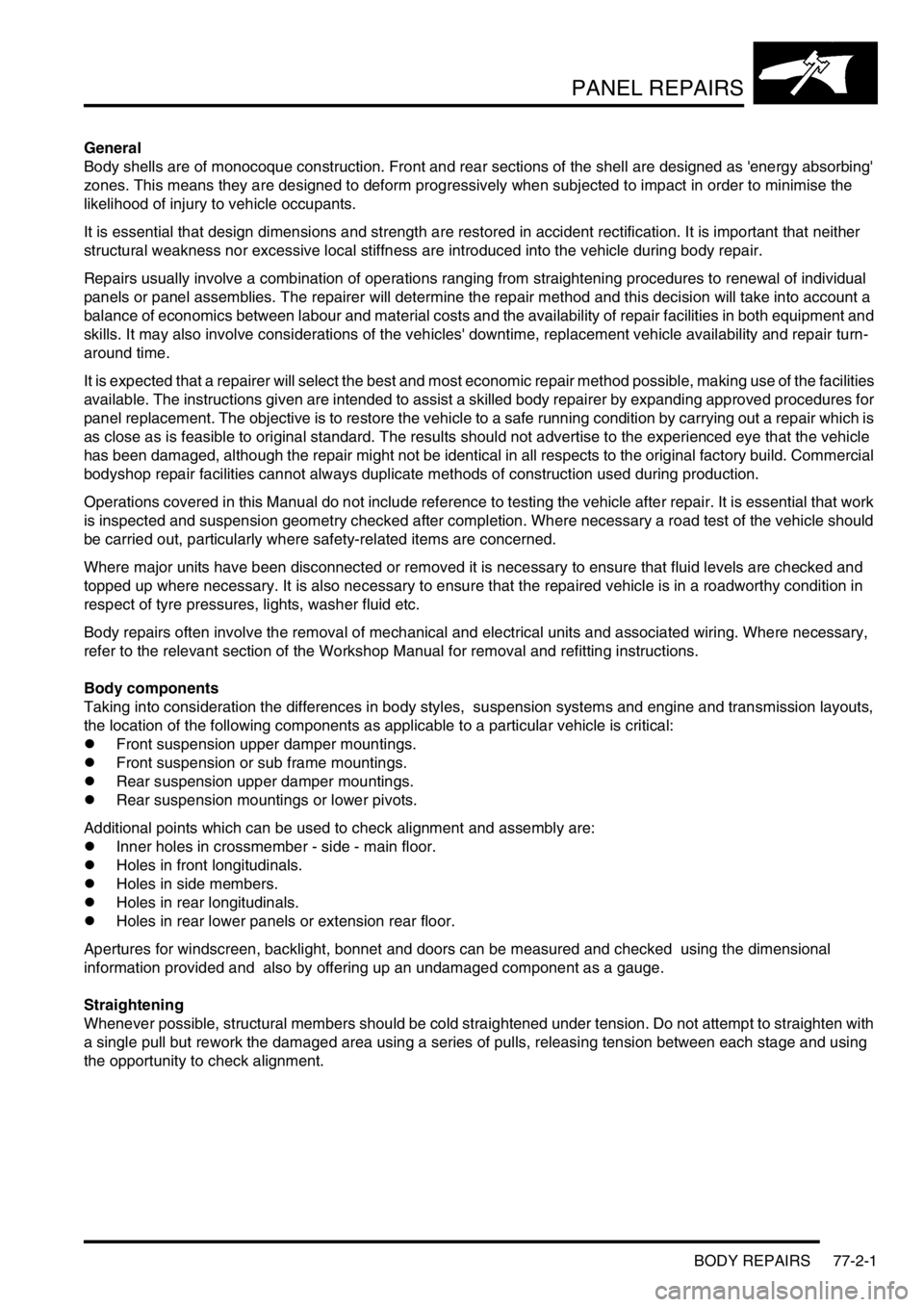check transmission fluid LAND ROVER FREELANDER 2001 Workshop Manual
[x] Cancel search | Manufacturer: LAND ROVER, Model Year: 2001, Model line: FREELANDER, Model: LAND ROVER FREELANDER 2001Pages: 1007, PDF Size: 23.47 MB
Page 437 of 1007

AUTOMATIC GEARBOX - JATCO
44-2 ADJUSTMENTS
Gearbox fluid - drain & refill
$% 44.24.02
Drain
1.Position vehicle on ramp.
WARNING: Observe due care when draining
gearbox fluid as the fluid can be very hot.
2.Apply handbrake and position chocks under
front and rear wheels.
3.Remove underbelly panel.
+ EXTERIOR FITTINGS, REPAIRS,
Panel - underbelly.
4.Position container under gearbox.
NOTE: The fluid should be drained with the
transmission at normal operating temperature.
5.Clean area around drain plug.
6.Remove drain plug and discard sealing washer.
7.Allow fluid to drain.
8.Clean drain plug and fit new sealing washer.
9.Fit drain plug and tighten to 45 Nm (33 lbf.ft).Refill
1.Clean area around filler plug.
2.Remove filler plug.
3.Add 3.5 to 4 litres of the correct fluid through
gearbox filler.
+ CAPACITIES, FLUIDS,
LUBRICANTS AND SEALANTS,
Lubrication.
4.Clean and fit filler plug.
5.Check and top-up fluid level.
+ MAINTENANCE, MAINTENANCE,
Automatic Gearbox – JATCO.
6.Fit underbelly panel.
+ EXTERIOR FITTINGS, REPAIRS,
Panel - underbelly.
M44 1641
M44 1642
Page 446 of 1007

AUTOMATIC GEARBOX - JATCO
REPAIRS 44-11
Oil seal - torque converter
$% 44.17.11
Remove
1.Remove gearbox assembly.
+ AUTOMATIC GEARBOX - JATCO,
REPAIRS, Gearbox - KV6.
+ AUTOMATIC GEARBOX - JATCO,
REPAIRS, Gearbox - Td4.
2.Remove torque converter from gearbox.
Discard 'O' ring from gearbox input shaft.
3.Remove torque converter oil seal from
gearbox. Discard torque converter oil seal.
CAUTION: When removing torque converter
oil seal take care not to damage oil pump
housing.Refit
1.Clean torque converter spigot.
2.Clean torque converter oil seal recess in
gearbox. Lubricate torque converter oil seal
with clean transmission fluid.
+ CAPACITIES, FLUIDS,
LUBRICANTS AND SEALANTS,
Lubrication.
3.Fit new torque converter oil seal using LRT-44-
024.
4.Lubricate and fit new 'O' ring to input shaft.
5.Fit torque converter.
6.Ensure converter is fully located in oil pump
drive by checking depth 'A' as illustrated.
lKV6 models: Depth A = 4 mm.
lTd4 models: Depth A = 27 mm.
7.Fit gearbox assembly.
+ AUTOMATIC GEARBOX - JATCO,
REPAIRS, Gearbox - KV6.
+ AUTOMATIC GEARBOX - JATCO,
REPAIRS, Gearbox - Td4.
M44 1659
A
Page 451 of 1007

AUTOMATIC GEARBOX - JATCO
44-16 REPAIRS
35.Remove 2 top bolts securing gearbox to
engine.
36.Release gearbox from 2 dowels.
37.Remove gearbox assembly.
38.Fit converter retaining plate and secure with
bolts.Refit
1.Remove torque converter retaining plate.
2.Ensure converter is fully located in oil pump
drive by checking depth 'A' as illustrated. Depth
A = 4 mm.
3.Clean gearbox to engine mating faces, dowels
and dowel holes.
4.Fit gearbox assembly.
5.Fit bolts securing gearbox and tighten to 85 Nm
(63 lbf.ft).
6.Disconnect lifting equipment.
7.Clean CKP sensor and mating face.
8.Fit CKP sensor, fit bolt and tighten to 9 Nm (7
lbf.ft).
9.Position fluid cooler, tighten M12 bolts to 85 Nm
(63 lbf.ft) and M8 bolt to 25 Nm (18 lbf.ft).
10.Connect hoses to fluid cooler.
11.Clean fluid cooler unions.
12.Lubricate new 'O' rings with clean transmission
fluid and fit 'O' rings to fluid cooler hoses.
+ CAPACITIES, FLUIDS,
LUBRICANTS AND SEALANTS,
Lubrication.
13.Connect fluid cooler hoses to gearbox and
tighten unions to 18 Nm (13 lbf.ft).
14.Clean starter motor mating faces.
15.Position starter motor to gearbox, align CKP
sensor multiplug bracket, fit and tighten bolts to
45 Nm (33 lbf.ft).
16.Using gearbox bracket bolts, secure LRT-44-
026 lifting bracket to gearbox.
17.Position IRD cooling hose retainer, fit bolt and
tighten to 25 Nm (18 lbf.ft).
18.Align marks on drive plate to torque converter.
19.Fit bolts securing drive plate to torque converter
and tighten bolts to 45 Nm (33 lbf.ft).
20.Clean torque converter access plate.
M44 1689
A
M44 1668
Page 756 of 1007

PANEL REPAIRS
BODY REPAIRS 77-2-1
PANEL REPAIRS
General
Body shells are of monocoque construction. Front and rear sections of the shell are designed as 'energy absorbing'
zones. This means they are designed to deform progressively when subjected to impact in order to minimise the
likelihood of injury to vehicle occupants.
It is essential that design dimensions and strength are restored in accident rectification. It is important that neither
structural weakness nor excessive local stiffness are introduced into the vehicle during body repair.
Repairs usually involve a combination of operations ranging from straightening procedures to renewal of individual
panels or panel assemblies. The repairer will determine the repair method and this decision will take into account a
balance of economics between labour and material costs and the availability of repair facilities in both equipment and
skills. It may also involve considerations of the vehicles' downtime, replacement vehicle availability and repair turn-
around time.
It is expected that a repairer will select the best and most economic repair method possible, making use of the facilities
available. The instructions given are intended to assist a skilled body repairer by expanding approved procedures for
panel replacement. The objective is to restore the vehicle to a safe running condition by carrying out a repair which is
as close as is feasible to original standard. The results should not advertise to the experienced eye that the vehicle
has been damaged, although the repair might not be identical in all respects to the original factory build. Commercial
bodyshop repair facilities cannot always duplicate methods of construction used during production.
Operations covered in this Manual do not include reference to testing the vehicle after repair. It is essential that work
is inspected and suspension geometry checked after completion. Where necessary a road test of the vehicle should
be carried out, particularly where safety-related items are concerned.
Where major units have been disconnected or removed it is necessary to ensure that fluid levels are checked and
topped up where necessary. It is also necessary to ensure that the repaired vehicle is in a roadworthy condition in
respect of tyre pressures, lights, washer fluid etc.
Body repairs often involve the removal of mechanical and electrical units and associated wiring. Where necessary,
refer to the relevant section of the Workshop Manual for removal and refitting instructions.
Body components
Taking into consideration the differences in body styles, suspension systems and engine and transmission layouts,
the location of the following components as applicable to a particular vehicle is critical:
lFront suspension upper damper mountings.
lFront suspension or sub frame mountings.
lRear suspension upper damper mountings.
lRear suspension mountings or lower pivots.
Additional points which can be used to check alignment and assembly are:
lInner holes in crossmember - side - main floor.
lHoles in front longitudinals.
lHoles in side members.
lHoles in rear longitudinals.
lHoles in rear lower panels or extension rear floor.
Apertures for windscreen, backlight, bonnet and doors can be measured and checked using the dimensional
information provided and also by offering up an undamaged component as a gauge.
Straightening
Whenever possible, structural members should be cold straightened under tension. Do not attempt to straighten with
a single pull but rework the damaged area using a series of pulls, releasing tension between each stage and using
the opportunity to check alignment.